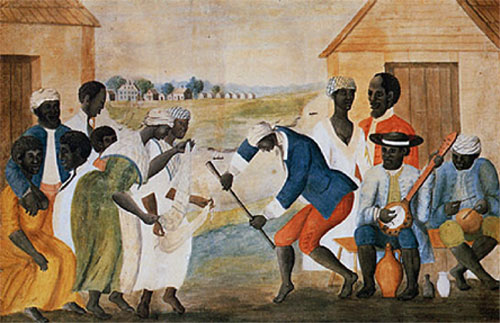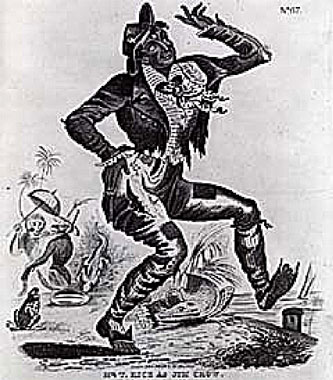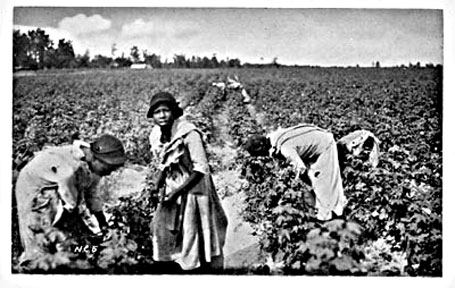Plantation Music Online History

Yes the slave plantation was an OPRESSIVE ATMOSPHERE...What did you think, tea and crumpets?
But the captive slaves did have a way of releasing stress... using their inner creative spirit! I often wonder how such a wonderful music like JAZZ could come from such an oppressive environment as the plantation...
Slave mimes and masqueraders, unlike their impersonators, performed largely their own folk music, dances, and comic skits at their festivals.
That's right... There was actually time to "party" on the plantation! Who would have thunk it? Just goes to show you, there is alot of history that is just not spoken about...
On occasion such festivals served the slave community as opportunities where slave entertainers could poke fun good-naturedly at each other, as well as at their slave master, without giving offense.
In 1832, for example, James Hungerford, then a young law student, observed a slave miming festival held at a plantation along the eastern shore of Maryland and noted that slaves impersonated their master, who seemed as amused by their “laughable imitations” of him as they were.
Tell me these African cats were not cool! They still were able to "diss" the master in their own way! And not get lynched!
Later, in 1909 the African-American composer John Rosamond Johnson connected the banjo instrumental accompaniment used for such plantation-type dances with the origin of ragtime music.
We'll get down with Ragtime Music on another page! Or if you are too hungry to wait check it out now honey-pie!
plantation music, jazz history

And if you want to take it even further dude... check out the way the plantations are still affecting today's culture!
In 1997 Eileen Southern similarly commented on young African-American musicians reviving and tweaking musical practices from the past, connecting in one instance performance practices associated with one slave plantation dance, the Juba dance, to “rap.” According to Southern,
The origins of rap can be traced to any number of sources … There is a longstanding tradition in the black community of using language creatively in everyday life. “Pattin’ Juba,” …
[a slave dance]
which dates from the early nineteenth century, was often a two-person operation: the patter provided dance music and a second person accompanied him, or her, reciting verses that were made up on the spur of the moment. (Southern, Music of Black Americans 602)
My question to you my fellow "Jazz-Cat traveller": How would you try to survive working in the fields with the hot burning sun on your butt? Picking cotton... watching your people be humiliated and hung?
Another example of black expressive culture that interests me in the US is found in the study of the slave masking and miming festivals of the antebellum South (another word for OLD SLAVE OWNING TIME)and the cultural traditions that evolved from them.
These festivals had their roots in the West African masking and miming festivals that slaves continued in the United States.
They later served as great material for several genres of American popular entertainment in the nineteenth and twentieth century, including Ethiopian minstrelsy, a crude blackened-faced parody on African-American folk life and culture, ragtime, and (probably rap, one of America’s most popular music styles...

And lets not forget about the black church people!
The folk-oriented black church, the oldest institution owned by the African-American FOLKS DOWN SOUTH. Within that tradition, the earliest repertory of sacred song is black hymnody (called variously Baptist “lined-out hymns,” “lining hymn,” or “Dr. Watts”), which can still be heard in folk-oriented black churches across the United States today.
This practice dates from the colonial era when some slaves were converted to the Protestant religion of their masters.
Never fully assimilated into mainstream colonial American life, these slaves created a folk style of religious expression by superimposing African tribal rituals and traditions upon European-American Protestantism (Du Bois, Negro Church 5).
I just love how these Black cats "muddied" the religious water of there slave owners and put some soul into it!
I guess they figured the European church needed some more soul! HAHAHA!
Several eighteenth- and nineteenth-century Anglo-Americans commented about the distinctiveness of the religious observances of early African Christians in America.
The influential clergyman John Leland, a standard bearer for early Baptists in America, remarked in his Virginia Chronicle (1790) that
They [the slaves] are remarkable for learning a tune soon, and have very melodious voices … When religion is lively they are remarkably fond of meeting together, to sing, pray, and exhort, and sometimes preach, and seem to be unwearied in the exercise. …
They commonly are more noisy in time of preaching, than the whites, and are more subject to bodily exercise, and if they meet with encouragement in these things, they often grow extravagant.” (qtd. in Green 98)
John Fanning Watson, a Wesleyan Methodist, described the religious excesses of blacks in Philadelphia in the early 1800s in a monograph, entitled Methodist Error of Friendly Advice to Those Methodists Who Indulge in Extravagant Religious Emotions and Bodily Exercises.
Watson complained in his epistle that poorly educated black Methodists sang unapproved, unintelligible songs of their own composition in divine worship, and that they performed these songs in “the chorus manner of southern harvest field, or husking frolic method, of the slave blacks”, accompanied by actual dancing in church.
In his words, “What in the name of religion [could] countenance or tolerate such gross perversion of true religion?
Back to Jazz History Page





